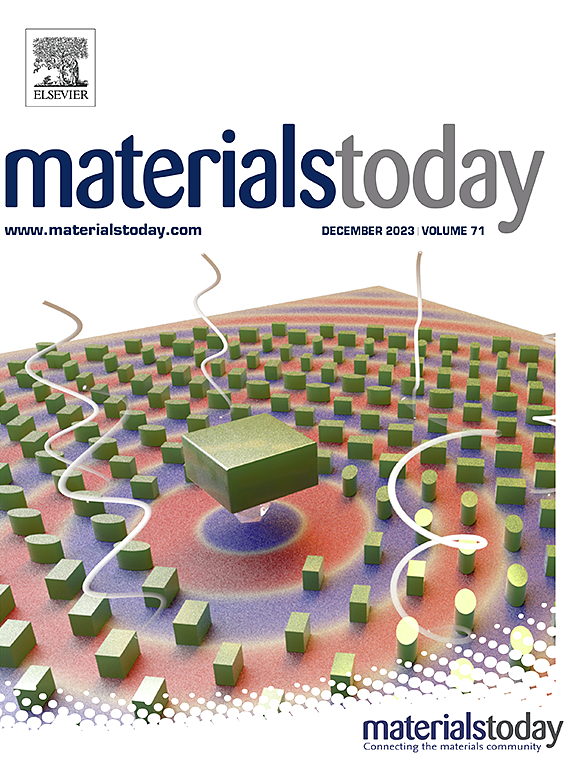Unraveling the molecular mechanisms of antisolvent action in localized high-concentration electrolytes for lithium metal batteries
IF 21.1
1区 材料科学
Q1 MATERIALS SCIENCE, MULTIDISCIPLINARY
引用次数: 0
Abstract
Localized high-concentration electrolytes (LHCEs) stand out as a promising strategy for boosting the energy density of lithium metal batteries (LMBs). While extensive research has been conducted on LHCEs, the molecular-level mechanisms by which antisolvents function remain partially elusive. This study employs a combination of spectroscopic analysis and computational methods to investigate the impact of the antisolvent 1,1,2,2-tetrafluoroethyl 2,2,3,3-tetrafluoropropyl ether (TTE) on the solvation structures within carbonate-based LHCEs. Our results suggest that the incorporation of TTE modifies the Li+ solvation structure by decreasing the dimethyl carbonate (DMC) concentration and increasing the anion proportion in the solvation shell, thereby enhancing Li+ transport. Furthermore, two-dimensional infrared (2D IR) spectroscopy discloses that elevated TTE content cause the decrease of the inhomogeneous components of LHCEs, and limited spectral diffusion relaxation dynamics are related to the refined aggregates in higher TTE addition. Most notably, 2D IR spectroscopy enables the detection of the ultrafast dynamics within the solvation structure. Specifically, at higher TTE concentrations, there is a swift energy transfer between Li+-DMC and free DMC. The picosecond-scale disparity in energy transfer times implies a possible link to the effectiveness of Li+ transport. As such, this research deepens our comprehension of the role of antisolvents and provides novel insights into their influence on the microstructure of LHCEs.

局部高浓度锂金属电池电解液抗溶剂作用的分子机制研究
局部高浓度电解质(LHCEs)是提高锂金属电池(lmb)能量密度的一种很有前途的策略。虽然对lhce进行了广泛的研究,但反溶剂作用的分子水平机制仍然部分难以捉摸。本研究采用光谱分析和计算相结合的方法研究了抗溶剂1,1,2,2-四氟乙基2,2,3,3-四氟丙基醚(TTE)对碳酸盐基lhce中溶剂化结构的影响。我们的研究结果表明,TTE的加入通过降低碳酸二甲酯(DMC)浓度和增加溶剂化壳中阴离子的比例来改变Li+的溶剂化结构,从而增强Li+的运输。二维红外(2D IR)光谱分析表明,TTE含量的增加导致lhce的非均质成分减少,而高TTE添加量下聚集体的细化与有限的光谱扩散弛豫动力学有关。最值得注意的是,二维红外光谱可以检测到溶剂化结构内的超快动力学。具体来说,在较高的TTE浓度下,Li+-DMC和游离DMC之间存在快速的能量转移。皮秒尺度的能量转移时间差异暗示了与Li+输运效率的可能联系。因此,本研究加深了我们对反溶剂作用的理解,并为它们对lhce微观结构的影响提供了新的见解。
本文章由计算机程序翻译,如有差异,请以英文原文为准。
求助全文
约1分钟内获得全文
求助全文
来源期刊

Materials Today
工程技术-材料科学:综合
CiteScore
36.30
自引率
1.20%
发文量
237
审稿时长
23 days
期刊介绍:
Materials Today is the leading journal in the Materials Today family, focusing on the latest and most impactful work in the materials science community. With a reputation for excellence in news and reviews, the journal has now expanded its coverage to include original research and aims to be at the forefront of the field.
We welcome comprehensive articles, short communications, and review articles from established leaders in the rapidly evolving fields of materials science and related disciplines. We strive to provide authors with rigorous peer review, fast publication, and maximum exposure for their work. While we only accept the most significant manuscripts, our speedy evaluation process ensures that there are no unnecessary publication delays.
 求助内容:
求助内容: 应助结果提醒方式:
应助结果提醒方式:


